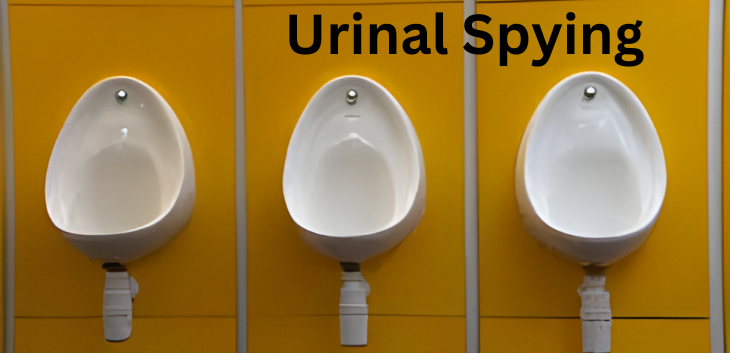Discover the unsettling reality of urinal spying and how it poses a threat to privacy. Learn about the methods used, the legality surrounding it, and how to protect yourself from this invasive practice.
Introduction: The clandestine act of urinal spying is a disturbing invasion of privacy that has garnered attention in recent years. From hidden cameras to peeping toms, individuals have fallen victim to this reprehensible violation while in vulnerable states. In this comprehensive guide, we delve into the intricacies of urinal spying, shedding light on its prevalence, methods, legal implications, and protective measures.
Table Of Contents
Urinal Spying: An Unsettling Reality
Understanding Urinal Spying
Urinal spying’s, a nefarious practice, involves the surreptitious surveillance of individuals in public or private restroom facilities. Perpetrators deploy various means to obtain illicit footage or visual access, compromising the privacy and dignity of unsuspecting victims.
Methods Employed
- Hidden Cameras: Hidden cameras discreetly installed in restroom facilities capture intimate moments without consent, perpetuating the violation of privacy laws.
- Peeping Toms: Predatory individuals resort to peeping over or under restroom stall partitions to observe individuals in compromising positions.
- Smartphone Recording: Unscrupulous individuals may use smartphones to record or livestream footage of individuals using restroom facilities. Exploiting technological advancements for nefarious purposes.
Prevalence of Urinal Spying
Despite being an underreported phenomenon, instances of urinal spying have surfaced globally, prompting concerns about the adequacy of security measures in public and private restrooms.
Statistics and Case Studies
- Global Incidents: Reported cases of urinal spying span across various countries, indicating the widespread nature of this violation.
- Impact on Victims: Victims of urinal spying experience profound distress and psychological trauma, highlighting the detrimental effects of privacy breaches on mental well-being.
Legality and Ethical Considerations
The legality of urinal spying’s varies depending on jurisdiction, with many countries enacting laws to address this reprehensible act. Ethical considerations surrounding privacy rights and consent underscore the importance of robust legislation to combat urinal spying’s.
Legal Framework
- Privacy Laws: Legislation governing privacy rights and protections play a pivotal role in deterring and prosecuting perpetrators of urinal spying.
- Penalties and Prosecutions: Perpetrators found guilty of urinal spying may face severe penalties, including fines and imprisonment, underscoring the gravity of this offense.
Protective Measures Against Urinal Spying
In light of the pervasive threat posed by urinal spying, individuals must take proactive steps to safeguard their privacy and well-being in restroom facilities.
Safety Tips
- Visual Inspection: Conduct visual sweeps of restroom facilities to identify any suspicious objects or irregularities that may indicate the presence of hidden cameras.
- Awareness Campaigns: Promote awareness and education regarding urinal spying’s to empower individuals to recognize and report instances of this violation.
- Legal Advocacy: Advocate for the enactment and enforcement of robust privacy laws to combat urinal spying and hold perpetrators accountable.
FAQs (Frequently Asked Questions)
What are the legal consequences of urinal spying’s?
Perpetrators of urinal spying’s may face legal repercussions, including fines, imprisonment, and civil liabilities, depending on the severity of the offense and applicable laws.
How can individuals protect themselves from urinal spying’s?
To protect against urinal spying’s, individuals should remain vigilant, conduct visual inspections of restroom facilities, report suspicious activities to authorities, and advocate for stronger privacy protections.
Is urinal spying’s more prevalent in certain locations?
Urinal spying’s can occur in various settings, including public restrooms, workplaces, and private residences, emphasizing the importance of maintaining vigilance and implementing protective measures.
Are there any technological solutions to prevent urinal spying’s?
Technological advancements such as anti-surveillance devices and privacy-enhancing technologies may offer mitigation against urinal spying’s, but comprehensive solutions require a multifaceted approach encompassing legislation, awareness, and advocacy.
What psychological effects can victims of urinal spying’s experience?
Victims of urinal spying’s may experience profound psychological distress, including anxiety, paranoia, and trauma, highlighting the pervasive impact of privacy violations on mental well-being.
What recourse do victims of urinal spying’s have?
Victims of urinal spying’s can seek recourse through legal channels by reporting incidents to law enforcement, pursuing civil litigation against perpetrators, and advocating for policy reforms to prevent future violations.
Conclusion:
Urinal spying represents a reprehensible violation of privacy that undermines individual dignity and autonomy. By raising awareness, advocating for legislative reforms. And implementing protective measures. We can collectively combat this insidious threat and uphold the fundamental right to privacy in restroom facilities.


